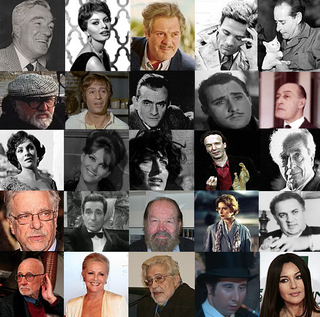Italian cinema
| Cinema of Italy | |
|---|---|

Some of the notable actors and filmmakers
|
|
| No. of screens | 3,217 (2011) |
| • Per capita | 5.9 per 100,000 (2011) |
| Main distributors |
Medusa Film S.P.A. 16.7% Warner Bros. Italia S.P.A. 13.8% 20th Century Fox Italia S.P.A. 13.7% |
| Produced feature films (2013) | |
| Total | 167 |
| Number of admissions (2013) | |
| Total | 97,380,572 |
| • Per capita | 1.50 (2012) |
| National films | 30,208,422 (31.0%) |
| Gross box office (2013) | |
| Total | €618 million |
| National films | €188 million (30.5%) |
The Cinema of Italy comprises the films made within Italy or by Italian directors. Since the development of the Italian film industry in the early 1900s, Italian filmmakers and performers have, at times, experienced both domestic and international success, and have influenced film movements throughout the world. As of 2014, Italian films have won 14 Academy Awards for Best Foreign Language Film, the most of any country, as well as 12 Palmes d'Or, the second-most of any country.
Early Italian films were typically adaptations of books or stage plays. By the 1910s, Italian filmmakers were utilizing complex set designs, lavish costumes, and record budgets, to produce pioneering films such as Enrico Guazzoni's Quo Vadis (1913) and Giovanni Pastrone's Cabiria (1914). One of the first cinematic avante-garde movements, Italian Futurism, took place in Italy in the late 1910s. After a period of decline in the 1920s, the Italian film industry was revitalized in the 1930s with the arrival of sound film. A popular Italian genre during this period, the Telefoni Bianchi, consisted of comedies with glamorous backgrounds.
While Italy's Fascist government provided financial support for the nation's film industry, most notably the construction of the Cinecittà studios, it also engaged in censorship, and thus many Italian films produced in the late 1930s were propaganda films. Post-World War II Italy saw the rise of the influential Italian neorealist movement, which launched the directorial careers of Luchino Visconti, Roberto Rossellini, and Vittorio De Sica. Neorealism declined in the late 1950s in favor of lighter films, such as those of the Commedia all'italiana genre and important directors like Federico Fellini and Michelangelo Antonioni. Actresses such as Sophia Loren, Giulietta Masina and Gina Lollobrigida achieved international stardom during this period.
...
Wikipedia
